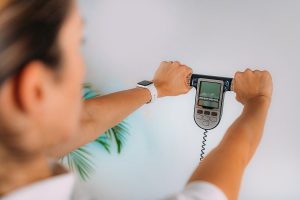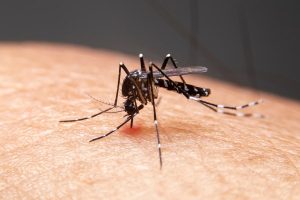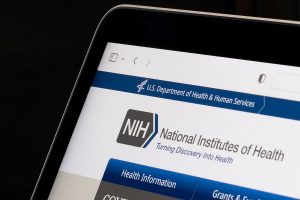As the U.S. coronavirus case count neared 5 million on Thursday, a new model predicted that nearly 300,000 Americans could die of COVID-19 by December if more people don’t wear masks or practice better social distancing.
Researchers from the University of Washington’s Institute for Health Metrics and Evaluation (IHME) on Thursday issued a forecast of 295,011 deaths from coronavirus by Dec. 1.
However, if 95 percent of people were to wear a face mask in public, some 66,000 lives could be saved, they added.
“We’re seeing a rollercoaster in the United States,” institute director Christopher Murray said in a statement. “It appears that people are wearing masks and socially distancing more frequently as infections increase, then after a while as infections drop, people let their guard down and stop taking these measures to protect themselves and others which, of course, leads to more infections. And the potentially deadly cycle starts over again.”
His team’s model also identifies which states will need to re-impose mask mandates between now and the winter to slow the spread of transmission.
In other pandemic news, the U.S. State Department on Thursday lifted its 5-month-old blanket warning against international travel for Americans. Instead, the department will now issue travel recommendations by country.
Why the change? “Health and safety conditions improving in some countries and potentially deteriorating in others” influenced its decision, the state department said in a statement Thursday. The change will allow travelers to make “informed decisions” based on the situation in specific countries, officials said.
“We continue to recommend U.S. citizens exercise caution when traveling abroad due to the unpredictable nature of the pandemic,” the agency’s statement said.
Despite the lifting of the travel warning, many other countries are currently restricting American citizens from entry because the United States has far more coronavirus cases than any other nation in the world, the Washington Post reported.
Scientists call for faster tests
To try to better track and stem the spread of coronavirus, scientists on Wednesday called for widespread adoption of simpler, less accurate tests, as long as they’re given often and quickly.
“Even if you miss somebody on Day 1,” Omai Garner, director of clinical microbiology in the UCLA Health System, told The New York Times. “If you test them repeatedly, the argument is, you’ll catch them the next time around.”
The strategy hinges on having an enormous supply of testing kits. But many experts believe more rapid, frequent testing would spot people who need immediate medical care while also identifying those most likely to spread COVID-19, the Times reported.
Of the dozens of coronavirus tests that have been granted emergency use authorization by the U.S. Food and Drug Administration, most rely on complex laboratory procedures, such as PCR, the Times reported.
Only a few tests are quick and simple enough to be run in a doctor’s office or urgent care clinic, without the need for lab equipment. And these tests are still relatively scarce nationwide, though government officials say they plan to ramp up production of such tests by the fall, the newspaper said.
“If you had asked me this a couple months ago, I would have said we just need to be doing the PCR tests,” Susan Butler-Wu, a clinical microbiologist at the University of Southern California, told the Times. “But we are so far gone in this country. It is a catastrophe. It’s kitchen sink time, even if the tests are imperfect.”
The governors from seven states have already taken testing matters into their own hands, banding together to shorten turnaround time for COVID-19 test results.
Three Republican governors and three Democratic governors signed an interstate testing agreement on Tuesday, the Times reported. Louisiana, Maryland, Massachusetts, Michigan, Ohio and Virginia will work with the Rockefeller Foundation and two U.S. manufacturers of rapid tests to buy 3 million tests, the newspaper said.
A seventh state, North Carolina, later joined the pact, CNN reported.
Final stage vaccine trials underway
On the vaccine front, the final phases of testing for two potential COVID-19 vaccines have been launched.
In one trial, the first of 30,000 volunteers will be given either a vaccine developed by Moderna Inc. and the U.S. National Institutes of Health or a placebo shot, the Post reported.
Pharmaceutical giant Pfizer has also announced that it was starting a 30,000-person final phase vaccine trial, to be conducted at 120 sites globally.
Fauci predicted that researchers would probably be able to tell whether the Moderna vaccine was effective by November or December, although he added that it was a “distinct possibility” an answer could come sooner. Pfizer officials have said the company expects to be able to seek regulatory authorization or approval for its vaccine by October, the Post reported.
As cases have surged and testing delays have followed, contact tracing is becoming irrelevant in many parts of the country.
In many cities in Florida, a state which saw its case count pass 500,000 on Wednesday, officials have largely given up on tracking cases, and the situation is equally grim in California, the Times reported.
“I think it’s easy to say contact tracing is broken,” Carolyn Cannuscio, an expert on the strategy and an associate professor of family medicine and community health at the University of Pennsylvania, told the Times. “It is broken because so many parts of our prevention system are broken.”
By Friday, the U.S. coronavirus case count neared 5 million as the death toll exceeded 159,500, according to a Times tally.
According to the same tally, the top five states in coronavirus cases as of Friday were: California with nearly 541,000; Florida with more than 510,000; Texas with over 488,000; New York with over 423,600; and New Jersey with more than 185,500.
Nations grapple with pandemic
Elsewhere in the world, the situation remains challenging.
Cases of the coronavirus in France are spiking once again, the Post reported. The country recorded its highest daily total of infections since May on Wednesday, with at least 1,695 positive cases reported over 24 hours.
Spain also recorded an uptick in new cases, fueling fears of a second outbreak in Europe as countries attempt to return to normal life, the Post reported.
In Australia, the premier of Victoria has declared a “state of disaster,” announcing even stricter lockdown measures, including a nightly curfew and banning virtually all trips outdoors.
“We have to do more, and we have to do more right now,” said Premier Daniel Andrews. “Where you slept last night is where you’ll need to stay for the next six weeks.”
Things continue to worsen in India. Over the course of two days, the country reported more new cases and deaths than the United States and Brazil, a sign that it may soon outpace them, the Post reported. On Aug. 4 and 5, India had over 50,000 new cases and more than 800 deaths, while the caseload in the United States remained below 50,000 and less than 700 deaths were reported.
On Friday, the country passed 2 million infections and over 41,500 deaths, a Johns Hopkins tally showed. The surge comes weeks after a national lockdown was lifted, and it’s prompted some parts of the country to revert back to stricter social distancing measures.
Brazil is also a hotspot in the coronavirus pandemic, with over 2.9 million confirmed infections by Friday, according to the Hopkins tally. It has the second-highest number of cases, behind only the United States.
Cases are also spiking wildly in Russia: As of Friday, that country reported the world’s fourth-highest number of COVID-19 cases, at over 875,000, the Hopkins tally showed.
Worldwide, the number of reported infections passed 19 million on Friday, with over 715,000 deaths, according to the Hopkins tally.
More information
The U.S. Centers for Disease Control and Prevention has more on the new coronavirus.
Source: HealthDay
Copyright © 2025 HealthDay. All rights reserved.

















